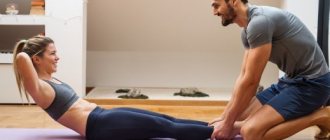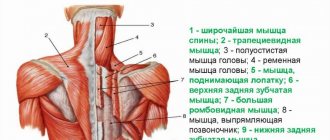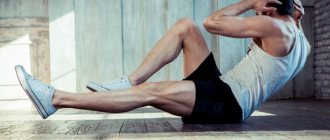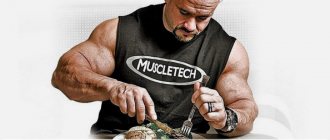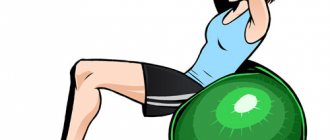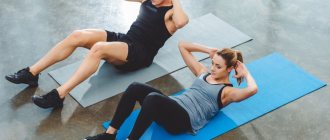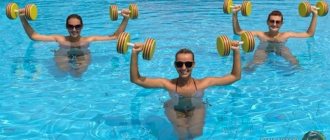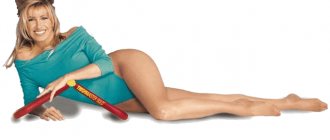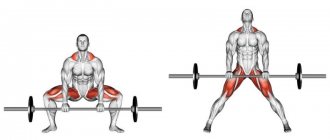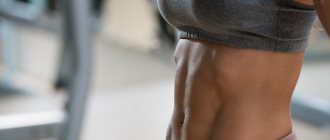Anatomy of the lateral abdominal muscles
The oblique abdominal muscles are located on the sides of the body. They are responsible for its rotation (turns), tilts and perform a stabilizing function, keeping the body level. Also, these muscles help hold the internal organs. If we want to have an even posture, then strengthening the obliques should be a must in your training. Two muscles in this area can be distinguished:
- External oblique. Forms the top layer of oblique muscles. It is this that forms the so-called lateral press. Its functions include twisting and bending of the body. It also gives us the opportunity to lean forward. And when lifting heavy weights, it stabilizes the spine.
- Internal oblique. It is located under the outer one. Due to the fact that it is attached to the lower part of the ribs, it lowers them during movement. With unilateral contraction, it turns the body in this direction. When two internal muscles contract at once, the body bends forward.
The external and internal muscles are constantly under tension when we stand. Allowing us to maintain an upright position.
Why pump up your oblique abdominal muscles?
There are several reasons to pay attention to working these muscles:
- Protecting your back from pain . The abdominal muscles form A PILOT STUDY OF CORE STABILITY AND ATHLETIC PERFORMANCE: IS THERE A RELATIONSHIP? a rigid cylinder that stabilizes the spine and holds it in the desired position. Training these muscles helps Core Muscle Activity during Physical Fitness Exercises: A Systematic Review reduce the risk of musculoskeletal diseases associated with poor posture and a sedentary lifestyle.
- More efficient performance of everyday motor tasks . The condition of the core muscles directly affects the quality of movements in everyday life. By strengthening your obliques and other parts of your core, you'll be able to run better, lift weights more efficiently, and push and pull things harder.
- Improving performance in sports . Together with other parts of the body, the obliques transmit A PILOT STUDY OF CORE STABILITY AND ATHLETIC PERFORMANCE: IS THERE A RELATIONSHIP? forces from the lower extremities to the upper and vice versa. For example, when serving in tennis and baseball or striking in martial arts, muscle activation begins in the lower extremities, extends upward through the torso, and only ends with the movement of the arms. Strong abdominal muscles will improve the transfer of force, making movements more powerful and precise, which is useful in any sport.
- Reduces the risk of injury. Since the obliques, along with the rest of the core, are responsible for spinal stability and the ability to maintain balance, pumping them allows Core stability measures as risk factors for lower extremity injury in athletes, Core Muscle Activity during Physical Fitness Exercises: A Systematic Review to reduce the risk of injury.
Key Points Before Side Press Workout
It is very important to observe these points when training the lateral muscles. Since their development can affect the appearance of your waist.
Don't exercise on a full stomach
If you perform exercises for the oblique muscles on a full stomach, there may be unpleasant consequences. Such as dizziness or nausea. Therefore, you should wait 1-2 hours after eating. Giving the food time to digest. It is also not recommended to exercise on an empty stomach. After all, for a productive workout, the body needs energy. Where can you get it if there are no nutrients?
Before training you should stretch your muscles
Any physical activity is stressful for our body. And if you don’t warm up your muscles properly before training, you can easily get injured. To avoid this, you should perform a small WARM-UP complex. Particular attention should be paid to those muscles that will be most involved. In our case, these are oblique. For this, simple exercises such as bending and rotating the body are perfect.
It's not quantity that matters, but quality
Many people make one very fatal mistake. Namely, they perform abdominal crunches for a large number of repetitions. But they forget one very important detail. The oblique muscles are a muscle like any other. And for their development, 10 repetitions per set will be enough. The main thing is that when performing, we feel the muscle group that we are trying to load. So you should work on quality by developing neuromuscular connection. An exercise like VACUUM can help with this.
Excessive load
Although the abdominal muscles are very resilient. And it takes much less time to restore them. All the same, you should not overload them too much. Therefore, training the oblique muscles every day is a big mistake. Just 1-2 workouts per week is enough.
Eat right
No matter how hard we work on training our abdominal muscles, without proper nutrition we will not be able to evaluate the results of our labors. Since, due to the excess percentage of subcutaneous fat, they simply will not be visible. Therefore, it is worth reconsidering your diet if you want to create the body of your dreams. And at the same time have a narrow waist.
Workouts should be varied
The abdominal muscles are very fastidious. And they quickly get used to monotonous training. Therefore, they should be constantly surprised with new exercises. Luckily for the abs, there are a lot of them. At the same time, each exercise has the possibility of an easier version of it. So you don’t have to worry that you won’t be able to perform this or that element if you haven’t trained your oblique muscles before.
Stretching the muscles at the end of the workout
After a fruitful workout, you definitely need to stretch the working muscles. And the press is no exception. Stretching improves blood circulation. Calms the nervous system after hard work in the gym. Also, muscle pain will decrease and recovery will be much faster. So take 5 minutes at the end of your workout and reap the benefits.
Recommendations and tips for effective training
To pump up the lateral abdominal muscles, you need to know and follow the following rules:
- 2-2.5 hours before training you need to eat lightly;
It is not recommended to exercise on an empty stomach. Lack of energy does not allow you to give your best and reduces the effectiveness of your workout. You shouldn't overeat either. Exercising with a full stomach can cause dizziness, nausea and other unpleasant consequences.
- You need to start your training with a light warm-up;
To warm up your muscles, you need to jump, run on a treadmill or in place, and perform simple exercises such as bending, rotating, and turning.
- You should not overexert yourself - exhaust yourself;
Classes should take place two to four times a week. This is quite enough to pump up sculpted and beautiful abs.
- When performing exercises, you should feel a muscle stretch;
When you feel that the muscles in your abdomen are not tense, the exercise is performed incorrectly.
- Do not eat after training for an hour.
When you feel very hungry after exercising, you can drink a glass of water or eat an apple.
The muscles on the abdomen are quite difficult to stretch, and rapid fatigue is a normal reaction of the muscles to stress. The main thing is to carry out the training according to your level of training, moving from mastering easy to more difficult exercises.
How to Get V-Shaped Lower Abs (WITHOUT THE FOLLOWING BULLSHIT!!)
Side Press Exercises
There is a wide range of exercises to work the oblique muscles. Of course, you shouldn’t use everything at once in one workout. Choose 3-4, when performed, you feel the oblique muscles working.
Side crunches lying on your side
This exercise is very easy to perform. Therefore, if you have never worked your abs, especially your oblique muscles, then it is best to start with lateral crunches. To perform it, no equipment is needed. It is enough to purchase a fitness mat to make it more comfortable to lie on the floor. This exercise allows you to work the oblique muscles in isolation. In this case, the load on the back muscles is minimal.
Performance:
- We will consider the exercise when performed on the right side.
- Place a fitness mat on the floor. Sit on it lying on your right side.
- Bend your knees to a right angle of 90°
- Extend your right hand and place it on your thigh.
- Bend your left arm at the elbow and place your palm on the back of your head.
- Exhale and begin to bend your right side, trying to bring your left elbow closer to your thigh.
- At the peak point, hold for 1-2 seconds, allowing the oblique muscles to work statically. And while inhaling, return to the starting position.
When performing, the main task is to feel how the oblique muscles work. Don't pull yourself with your hand towards your hip. Flexion occurs only due to contraction of the lateral abdominal muscles. You should not make sudden movements. We work at a medium or slow pace. We concentrate on contracting and stretching the muscles. It is possible to add weights when performing these crunches. But it's better not to do this. Since lifting weights can affect the appearance of your waist.
Russian twist
This exercise is more complex. And in addition to the lateral ones, it also loads the rectus abdominis muscle. But this does not make its effectiveness any less. It can be performed either without weight or using weights. To do this, use a dumbbell or a barbell disc. But, as mentioned earlier, you should not chase weight. The main task is concentrated work on the oblique muscles.
Performance:
- We sit on the floor. The legs are slightly bent at the knee joint, the feet are on the floor.
- The back is straight, the body is slightly laid back.
- The arms are bent and clasped in front of the chest.
- Before you begin. Secure your hips, pelvis and shoulders. Movement should occur only in the waist area.
- As you exhale, we turn to the left side, trying to contract the side muscles as much as possible.
- Then we begin to inhale and at the same time, turn to the right side. And at the end of the turn we exhale.
We try to turn not due to inertia. It is not the weight that controls the movement, but us through the contraction of the abdominal muscles. We work at an average pace. We try to feel the work of the oblique abdominal muscles. During rotation, the pelvis should remain in place. No movements are allowed in it. In order to complicate the exercise, you can not only use additional weights. Just lift your feet off the floor and lift them up. So oblique, you will still have to work in statics, acting as stabilizers.
Bicycle exercise with rotation
This exercise is classified as light. But in practice it turns out that not everyone can cope with it. Because we need to control several things at once. First, leg movement. They don't have to do all the work alone. Our main goal is to load the oblique and rectus abdominis muscles. Therefore, the legs should be adducted by contracting the abdominal muscles. Secondly, rotation. That is, along with the adduction of the leg, we must rotate in its direction with the opposite side. At the same time, maintaining control over the abdominal muscles. Third, body stabilization. If we do not control its position, the execution can turn into simple swinging. It is very important to control all these points. Or the exercise may not reach its full potential. And your time will be wasted.
Performance:
- Place a mat on the floor and lie on your back.
- Tighten your rectus abdominis muscle. To do this, pull in your stomach and slightly round your back.
- The buttocks should be pressed.
- Bend your arms and place your palms on the back of your head.
- The legs are straightened and the heels are on the floor.
- As you exhale, bend one of your legs and pull it towards your stomach. At the same time, we turn and pull the opposite shoulder towards the knee.
- At this time, the second leg remains straight and at the same time we keep it suspended.
- While inhaling, we return to the starting position.
- As you exhale, do the same on the other leg.
- We alternate sides like this the legal number of times.
There is no need to pull your head towards your leg with your hands. This can damage your neck. The movement occurs due to the work of the oblique muscles. We try to work at full amplitude. Ideally, you should try to touch your knee with your elbow. Movements should be slow and controlled. The pace is medium or slow. If this movement is difficult for you, you should start with a simpler option. To do this, we lie down on the floor. Bend your leg and place one on top of the other. And in the same way, we reach out with the opposite shoulder towards her.
Exercise "Pendulum"
The classic version of this exercise is performed while lying on the floor. It can be easily performed by athletes of any level of training. This exercise specifically loads the lateral abdominal muscles. What makes it as effective as possible. If, when performing, you feel discomfort in the lumbar region, then bend your legs at the knee joint.
Performance:
- We lie down on the floor. We place our arms to the sides, legs together.
- The pelvis, shoulder blades and lower back are pressed. We raise straight (or bent for back pain) legs up until they become perpendicular to the floor.
- As you exhale, we begin to lower our legs to one side until our feet touch the floor.
- Next, we inhale and return to the starting position, and repeat the same in the other direction.
Do not hurry. The movement should occur due to the work of the oblique muscles. If you want to make the exercise more difficult, then place the ball between your feet or hang from a horizontal bar. When performing the pendulum exercise, you don’t have to worry that your waist will become wide.
Exercise "Lumberjack"
This is a complex movement that allows you to work all the abdominal muscles with an emphasis on the obliques. In this case, the back and shoulders are involved in the exercise. They call it that because the movement resembles the work of a woodcutter cutting down a tree trunk with an ax. It can be performed with or without weight. The best thing for this purpose is a crossover exercise machine or a rubber expander.
Performance:
- Lift the crossover block to the very top. Install a rope or D-shaped handle.
- We stand sideways to the crossover. We grasp the handle with both hands. We place our feet shoulder-width apart. For greater stability, you can bend them slightly at the knees.
- As you exhale, rotate your body toward the opposite hip. At the same time, we lower our hands and pull the handle behind us.
- Pause briefly at the bottom. And while inhaling, return to the starting position.
You can also do the lumberjack exercise from the lower block. The execution will be almost the same, only in reverse order. We pull the handle from the hip to the opposite shoulder, while making a rotational movement in the body. If you do not have access to a crossover, then you can perform the exercise with a dumbbell. We just take it in our hands and do the same movements as described above.
Side plank
This exercise is very different from the previous ones. In it, we do not strain the abs isometrically (without movement). That is, we hold the maximum voltage in it for a certain amount of time. This will allow you to tighten your abdominal muscles and make your waist much smaller. You can perform this exercise both in the gym and at home.
Performance:
- We take the emphasis while lying down, as with the classic PLANK.
- Next, we turn to one side, transferring the weight to the forearm and foot, which rest on the floor.
- The free hand can be raised up, placed behind the head and extended along the body.
- The body should not sag, especially in the pelvic area.
- We strain our abdominal muscles and hold it in this position for 10-15 seconds.
- Afterwards, we move the body weight to the other forearm and repeat the same thing.
When performing the plank, do not hold your breath. Your entire body should remain aligned throughout the entire exercise. If it is difficult to stand in this position, you can simplify the exercise a little. To do this, bend your lower leg at the knee and rest it on the floor.
Training the side muscles will help improve your figure. Don't forget your abs are the showcase of your body. The central part, the development of which should come first. But for some reason in the modern world they devote the least time to it. We are not talking about everyday training. A few intense workouts per week are enough to see results. If you find exercises difficult, start with easier versions. Do the plank on your knees, the bicycle with your legs crossed, and so on. This way you can constantly progress and achieve great results.
Good luck to everyone in your training!
Similar articles:
Features of abdominal training
The abdominal muscles can be exercised twice a week. However, there is no point in developing them throughout the entire training session, since the athlete will not be able to do 5-6 exercises of 2-3 approaches for one muscle group. The abdominals quickly start to burn, and overuse of this area can lead to lingering pain and muscle spasms for the next few days. The best option is to combine the exercise of the abdominal muscles with training other parts of the body. Abdominal exercises can be added to any workout plan. To ensure uniform development of this zone, it is recommended to add three exercises to the training program, one for each abdominal area. They can be performed both before training, since various twists and lifts perfectly prepare the lower back for training, and at the end of the session.
Second level
Has the first level become too easy for you? The second will help pump up your lateral abs at home, making them more prominent. Perform the techniques regularly, and your waist will decrease and your body will become toned. Each complex is performed 3-4 approaches 10-15 times.
Raises of the body and legs
Lying on a flat surface, place one arm under your head and straighten your legs. Raise your body and knee at the same time, touching each other. Return to the starting position and change hands.
Alternate body lifts
Lie down on a flat surface, place your hands at the back of your head, and bend your knees. Raise your body and at the same time turn, touching your right elbow to your left knee. Repeat the same with the other hand.
Knee Raise
Lie on your side, leaning on your elbow, straighten your legs, and place your hand that is at the top behind your back. Raise both legs towards your chest without touching the floor. Repeat the same on the other side.
On the horizontal bar
Performed from a hanging position, hands shoulder-width apart. Without bending your legs, do lateral raises, pausing at the maximum points.
Third level
The exercises described below are good for those who have been working on their lateral abdominal muscles for a long time. The number of repetitions and approaches can be adjusted independently, depending on your physical fitness.
Simple bends with weights
This exercise is difficult to perform because your lower back must be “trained.” However, it allows you to quickly and effectively pump up the oblique abdominal muscles.
Place your feet shoulder-width apart and place the bar on your trapezius. Do 15 side bends, trying to lower yourself as much as possible. Having lowered to the maximum point, stop for a couple of seconds and then smoothly return to the starting position. If you feel muscle tension, then you are doing the exercises correctly.
If you feel that there is not enough weight, add weights to the bar. When bending, keep your body straight and do not lean forward or backward. Return strictly to the starting position without deviating from the vertical.
Tilts with rotation
You could say this is a stronger version of the previous exercise because it targets the oblique muscle bundles.
Perform while standing, with your feet shoulder-width apart. A bar with plates (or without, if it’s hard) on the trapezes. You should bend forward and to the sides 15 times, while twisting your body. When doing crunches, the right elbow should be directed towards the left knee and vice versa.
Hanging turns
The exercise requires a horizontal bar and considerable strength, since these are really hard exercises for the abs. Starting position: hanging, hands shoulder-width apart. Straight legs should be raised so that they run parallel to the floor. Holding them in this position, describe an arc with the maximum possible amplitude. Make 10-15 such turns.
Woodcutter
These movements will also help narrow your waist. To perform this, stand sideways to the frame and grasp the handle of the upper block with both hands. Then make 12 chopping movements, while twisting the body towards the opposite shin.
